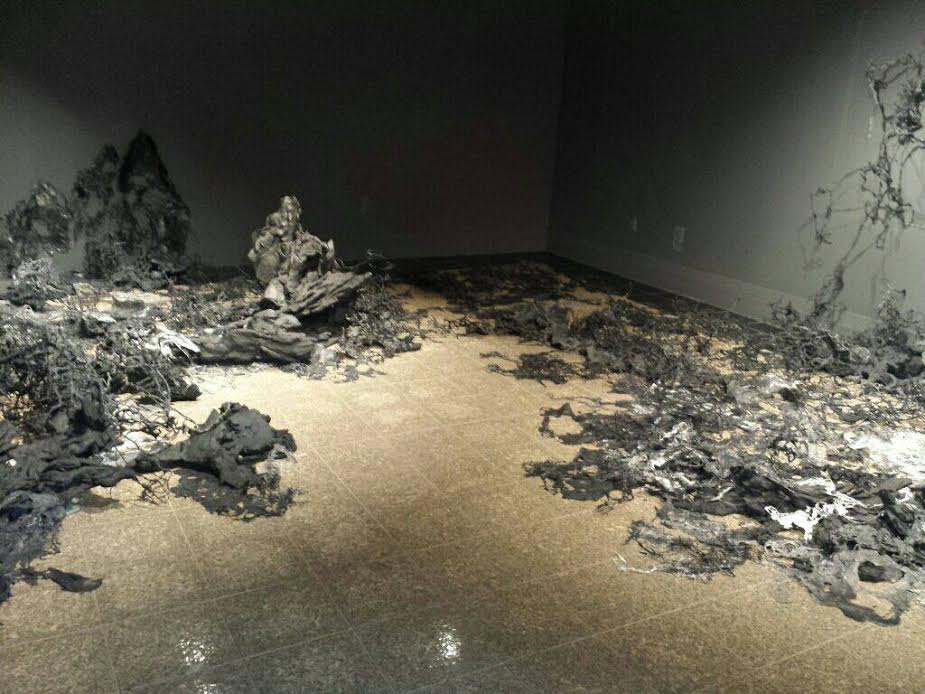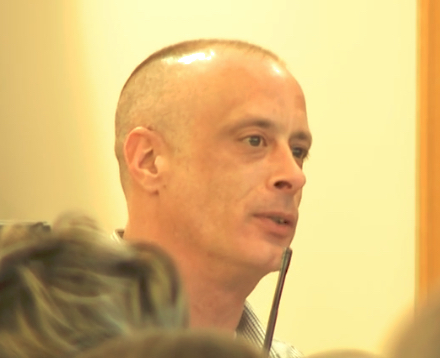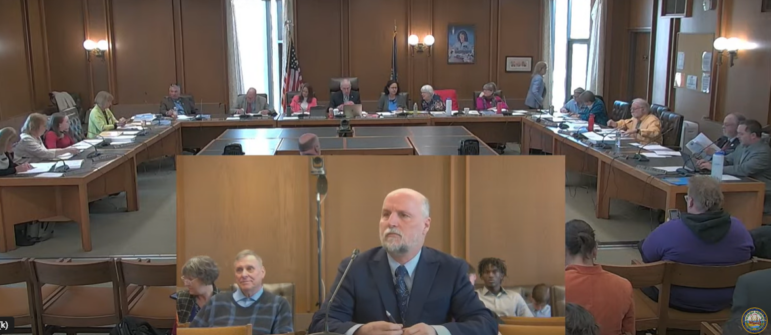By Ericka Broderick
When I asked sculptor Debra Weisberg what the exhibit she put together meant, she said: “Why don’t you tell me?”
I paused for a moment and looked around the room. My eyes darted across the floor covered with piles of black and white material resembling a pile of cobweb and twigs shaping in different forms. Scattered across the gallery, the material looked as if it was haunted or the result of a fire. The pieces looked burned and tarnished and almost abandoned.
Aside from the random figures scattered about, I was especially drawn to one pile of rubbish-looking sculpture resembling a man holding a woman in an embrace. The gallery walls, originally white, were painted dark gray to complement the exhibit. Along with the display, the exhibit was accompanied by the recording of the saddest of saxophones played by professional musician Ken Field in the background. Gripped by the tone, I was able to make my interpretation.
“Tragedy. Despair,” I told Weisberg.
She responded with her view of the exhibit as presenting the feeling of “melancholy.”
Just when I thought I got my answer, she continued with a much stronger tone, “I’m not trying to get people to decode it in language. I just want them to feel it.”
On the afternoon of Monday, February 20, 2017, Weisberg provided the finishing touches for a long week of installation of her exhibit at the McIninch Art Gallery.
Located within the campus of Southern New Hampshire University in Manchester, NH, the McIninch Art Gallery is prepared for an exhibit unlike anything they have presented before.
“I invited Debra Weisberg to create a site-specific installation for the McIninch Art Gallery because I wanted to have our SNHU community experience the environment that she creates with her sculpture and the music that was created to accompany her work,” said gallery director Deborah Disston.
She continued, “I also like to provide opportunities for established artists such as Debra with a ‘platform’ to develop a new body of work.”
The “platform” was exactly what made this particular exhibit unique. It was not made prior the installation. According to Weisberg, this was the “fourth iteration” of the exhibit. She explained at the opening of her exhibit later that week, “Each time I do it, there’s another layer of richness I decide to put into it”
Disston said, “Debra has worked for decades with materials that are malleable as well as rigid. She is also a very sophisticated draftsman who understands the nuances of drawing. In contemporary art, drawing is considered a form of mark making. Mark making is an act of expressing what the artist sees and feels in regard to place, people and things; it is not just the literal execution of drawing the figure or a still life.”
Weisberg specializes in installation artwork as she describes, “artwork that is temporary and made in response to space.” Her artwork depends on the space she is given. She responds to the floor like a “piece of paper.” Her biggest struggle with this specific gallery space was the “kitchen-looking” tile floor that differentiated it from other galleries. Weisberg said she had to ask herself, “How do I deal with all this pattern when my piece has so much texture?”
The answer was all about transformation. First it started with repainting the white walls a darker color. Then came the formation of her work. With the smaller pieces, she used wire and covered it with paper pulp and a carbon pigment. With the larger pieces she used camping foam mats that layered, where she cut them and coated them with rice paper. Weisberg described the materials as “malleable and mutable” in which they responded to her hand. 300 pieces later, the exhibit was complete. She declared, “Always knowing what you’re doing is overrated.”
“These did not come with a blueprint,” she said. “I made all the elements and put them in a space.”
Director Disston was able to directly observe Weisberg’s process. Disston said, “Her placements of the objects she created for this installation was much like drawing in the space, which necessitated her need to execute the installation by herself. The gallery assistants provided extra hands for removing materials or helping lift heavier objects that would be installed on the walls.”
One of the gallery assistants, Jerlin Quinones, 20, was not among the ones who helped Weisberg with the exhibit, but he did get to see it in its completion before it was presented. He was pleased with how it turned out.
“I think the new exhibit certainly looks interesting and very unique because I’ve never seen any art that’s similar. It looks very abstract, with very complex and intricate weaving that together creates a surreal landscape,” he said.
What made the exhibit officially come to life, however, was the music that accompanied it. Weisberg explained that providing music would allow the viewers of her exhibit to “slow down” and truly grasp their experience. “What I love about music is when you go to a live concert, you don’t ask, ‘What does it mean? What did it do?’ It penetrates,” she said.
This was the exact type of feeling Weisberg was trying to emulate. Through the assistance of saxophonist Ken Field, she was able to make it happen. At the opening of the exhibit, Field demonstrated with the different sounds he sampled into his computer with his sax. “I created sonic movement and textures,” he said. With these samples, he created two tracks for the gallery. One to be played in the front of the gallery and another to be played deeper within the gallery so that the two tracks “loop.” Some parts of the tracks even provided moments of silence.
Weisberg sent Field a list of words to help give him an idea of what type of sounds to play in these tracks. She provided him ideas like “darker tones, the quiet before the storm, and no recognizable sounds.” Such a track was aimed to help those who visit the gallery to get the full experience.
Weisberg said, “When there’s a sound, people immediately shut up.” She continued, “Whether you like my piece or not, it’s just to be present in it.”
Those who visited the gallery during the opening certainly felt present in the moment. They were instructed to leave their bags, food, and any sort of distractions outside of the gallery before entering. There were many varied reactions as a result.
Senior communication and business administration student Kamila Ataee, 23, managed to have the exhibit tap into her imagination. She said, “It was my first time coming into installations. It reminded me of some scenes from the movie Lord of the Rings …”
Senior game art and design student Mustapha Price, 21, said, “I thought it was pretty intense, a bit frightening. It makes me think of wreckage.”
Director Disston summed it up: “I think our visitors to the gallery will be pleasantly surprised by this experience.”
 Ericka Broderick is a junior at Southern New Hampshire University majoring in Communication with a double minor in Professional Writing and Music. She also works as a Social Media Assistant and a Peer Educator at SNHU.
Ericka Broderick is a junior at Southern New Hampshire University majoring in Communication with a double minor in Professional Writing and Music. She also works as a Social Media Assistant and a Peer Educator at SNHU.





